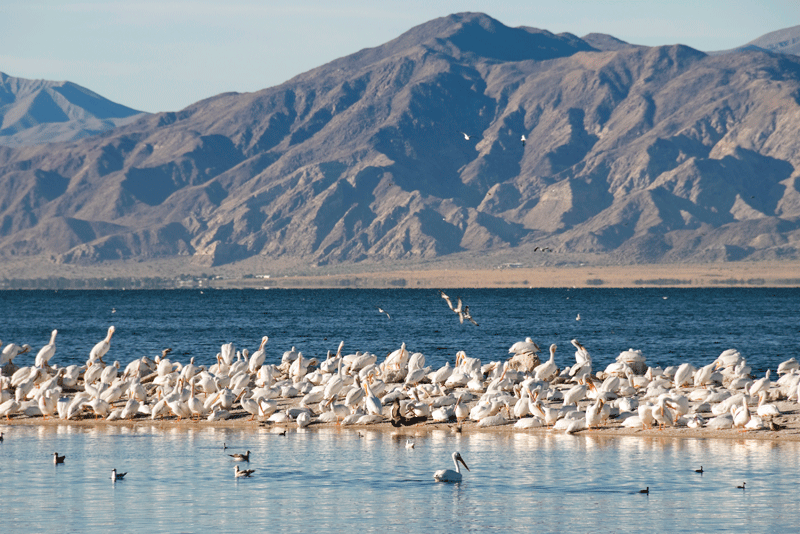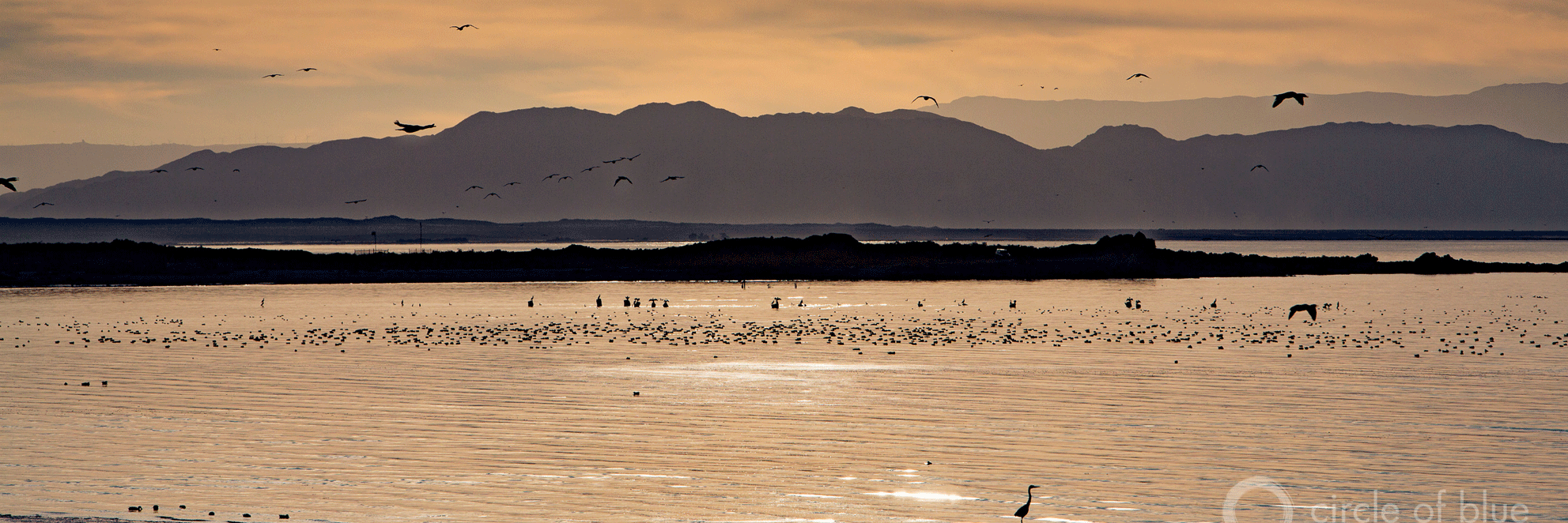By Michael Cohen
After decades of false starts and false hopes, progress might finally be within reach for California’s Salton Sea – the state’s largest and most maligned lake. California’s governor and natural resources secretary have demonstrated the commitment and political will needed to construct actual, on-the-ground habitat and dust control projects. California’s voters have approved hundreds of millions of dollars for Salton Sea projects. And the state and the largest local landowner recently completed land-use agreements to move the projects forward.
An Ebbing Sea
It’s long overdue. The Salton Sea’s surface has dropped by about 10 feet in twenty years – and almost two feet in just the past two years. At the dry flats of the former Red Hill Bay, the shoreline has already receded more than a mile since 1999. Salinity has increased by almost 50%. The Salton Sea is now almost twice as salty as the ocean. In 1999, there were some 100 million fish in the Sea. Now, more than 97 percent of those fish are gone.
In 1999, the Sea stood close to its highest elevation since it formed in 1905, lapping at dikes and berms erected along its shores to protect farmers’ fields. In 1999, the Salton Sea covered 375 square miles – about twice the size of Lake Tahoe. Since that time, the Sea has shrunk by more than 45 square miles – roughly the size of the City of San Francisco. In eleven years, the Salton Sea will likely be another 45 square miles smaller than it is today.
A Changing Landscape
California and the West have changed dramatically in the past twenty years. In 1999, the Bureau of Reclamation was developing plans to share surplus water because Lake Mead was almost full. Twenty years later, Lake Mead will end the year less than half full, its surface down almost 125 feet. Colorado River water users recently completed a drought contingency plan, to better manage the river for shortage. As climate change decreases run-off, shortage becomes the new normal, placing ever-greater pressure on an over-allocated and increasingly stressed Colorado River.
In 1999, the Imperial Valley-San Diego water transfer was still hotly debated and four years from being signed. This year, the Imperial Valley will send 160,000 acre-feet of Colorado River water to San Diego County and another 68,000 acre-feet to the Coachella Valley. Meanwhile, the total amount of water flowing into the Salton Sea this year could be 400,000 acre-feet less than in 1999.
In 1999, the Pacific Institute released Haven or Hazard, projecting the rapid decline of the Salton Sea and calling for prompt action to protect people and birds. We released Hazard in 2006, and Hazard’s Toll in 2014, estimating the public and ecological health costs of continued inaction at the Salton Sea.
A History of False Starts
The reality of the Salton Sea has changed dramatically in the past twenty years. Prospects for real action at the Sea continue to be elusive, cycling between brief periods of hope and years of subsequent frustration.
People have been planning to protect and restore the Salton Sea for more than fifty years. Twenty years ago, the Salton Sea Authority and the Bureau of Reclamation focused on managing salinity, with a pilot Enhanced Evaporation System and plans to impound portions of the lake to capture and manage salts.
The Imperial Valley-San Diego water transfer killed those plans – there wouldn’t be enough water to sustain them. But the upside was that, in facilitating the water transfer, California committed to “undertake the restoration of the Salton Sea ecosystem and the permanent protection of the wildlife dependent on that ecosystem.” The downside was that the water transfer did not include a volumetric fee, to pay for the significant annual operating costs that have subsequently and repeatedly delayed the construction of required habitat projects.
In early 2005, California convened a large Salton Sea Advisory Committee, charged with identifying a preferred alternative. Prop. 50 made tens of millions of dollars available. Yet in 2007, the state released a cobbled and bloated $8.9 billion ‘preferred alternative’ with no stakeholder support. The recession soon followed. Interest waned and the Sea’s prospects dimmed, again.

From 2006-2010, two federal agencies operated and monitored a 100-acre pilot wetland project near the Alamo River delta. The project included four shallow ponds fed by blended water from agricultural drainage and the Salton Sea. Thousands of birds, from more than 200 different species, used the ponds. California had the opportunity to take over the ponds in 2010, after the federal contract expired. Instead, the state shut down and drained the only operational habitat project at the Salton Sea, collecting and moving more than a million endangered desert pupfish from the ponds to an unknown fate.
In 2008, California began developing a consensus “no-regrets” plan, now called Species Conservation Habitat. Although it’s been fully permitted and fully funded for many years, the project has yet to begin construction. Once completed, SCH will cover 3,770 acres at the New River delta with a series of shallow wetlands, providing habitat for a broad mix of shorebirds and waterbirds and eliminating dust emissions by covering that playa.
In response to requests from environmentalists, California’s state water agency hired a Salton Sea Program Manager in 2010, to focus solely on expediting Salton Sea projects. Recognizing the lack of direction and vision for the Salton Sea, California enacted legislation that same year, creating a Salton Sea Restoration Council comprised of state and local stakeholders, with science and community advisory boards. The law required state agencies to staff the Restoration Council.
Governor Brown’s new administration did not staff the Restoration Council. In 2012, the legislature disbanded the Salton Sea Restoration Council at the governor’s request – because the unstaffed council had never met. The Salton Sea program languished, low on the list of the governor’s priorities.
Five years ago, the Imperial Irrigation District (IID) challenged the state’s indifference, petitioning for action at the Salton Sea. In response, the governor convened a state task force that, a year later, “directed agencies to develop a comprehensive management plan for the Sea that will:
- Meet a short-term goal of 9,000 acres to 12,000 acres of habitat and dust suppression projects, and
- Set a medium-term plan to construct 18,000 acres to 25,000 acres of habitat and dust suppression projects.
California hired an Assistant Secretary of Salton Sea Policy in 2015 as well – a new sign for hope. In late 2017, the state water regulator responded to IID’s petition with a new water order, creating explicit annual acreage milestones for state construction of habitat and dust control projects taken directly from the state’s own construction schedule. Governor Brown’s administration failed to meet those milestones.
Renewed Hope
But 2019 brought a new state administration and new enthusiasm and even hope for the Salton Sea.
The pieces are all in place for real action at the Salton Sea. Land use agreements have been signed. More than $350 million is available for Salton Sea projects, approved by California voters. Another $200 million or more has been authorized at the federal level but needs to get to California. More than 700,000 acre-feet of water – a staggering amount, much more than San Diego County uses each year – will continue to flow into the Salton Sea, available to support a host of habitat and dust control projects. We know what works; the 100-acre pilot projects that operated from 2006-2010 were quite successful. Completing and expanding the Species Conservation Habitat project, along with the Red Hill Bay project at the Alamo River delta and other similar habitat projects at the south end of the Salton Sea, combined with a deeper North Lake to provide recreational opportunities and better habitat for fish and the birds that eat them, offers a reasonable goal for the next five years. And – finally – the new governor and resources secretary are demonstrating the commitment and political will to hire and direct staff to get projects in the ground and protect public and environmental health.
Will 2019 mark the turning point, from hopes and plans to actual projects and the staff and funds needed to monitor and manage them over the long term?
In 1999 and 2000, research in a variety of disciplines led to a comprehensive understanding of the Salton Sea at the time. Yet the Salton Sea has changed dramatically in the past twenty years, and questions remain:
- What is our understanding of the Salton Sea now, of its inflows and water quality, of the invertebrates and fish that live in its waters, of the amount of dust blowing off of the more than 20,000 acres of lakebed exposed since 1999?
- What is in that dust? What’s being done to limit the amount of dust?
- What are the state’s plans for the Salton Sea?
- What are the local agencies planning for the Salton Sea?
- Are local communities being engaged in these state and local planning efforts?
- Will there be enough money to pay for these projects?
- Who will manage the projects over the next five or 10 or 25 years?
- Will 2019 really mark a turning point for the Salton Sea, or will it signal yet another false hope?
For answers to these questions and more, join us at the Salton Sea Summit in Palm Desert, California from October 17th to 18th 2019. Registration is free!


